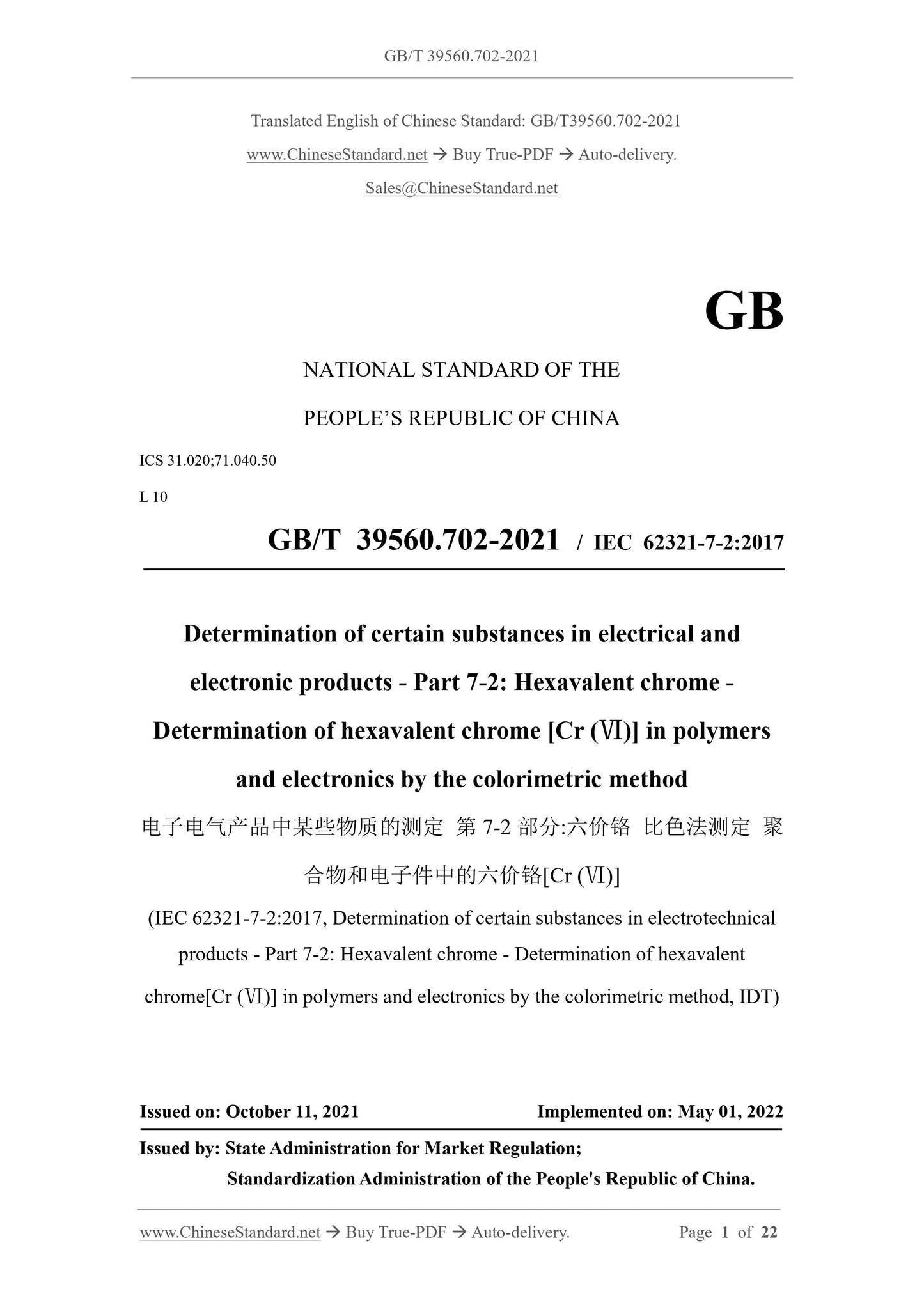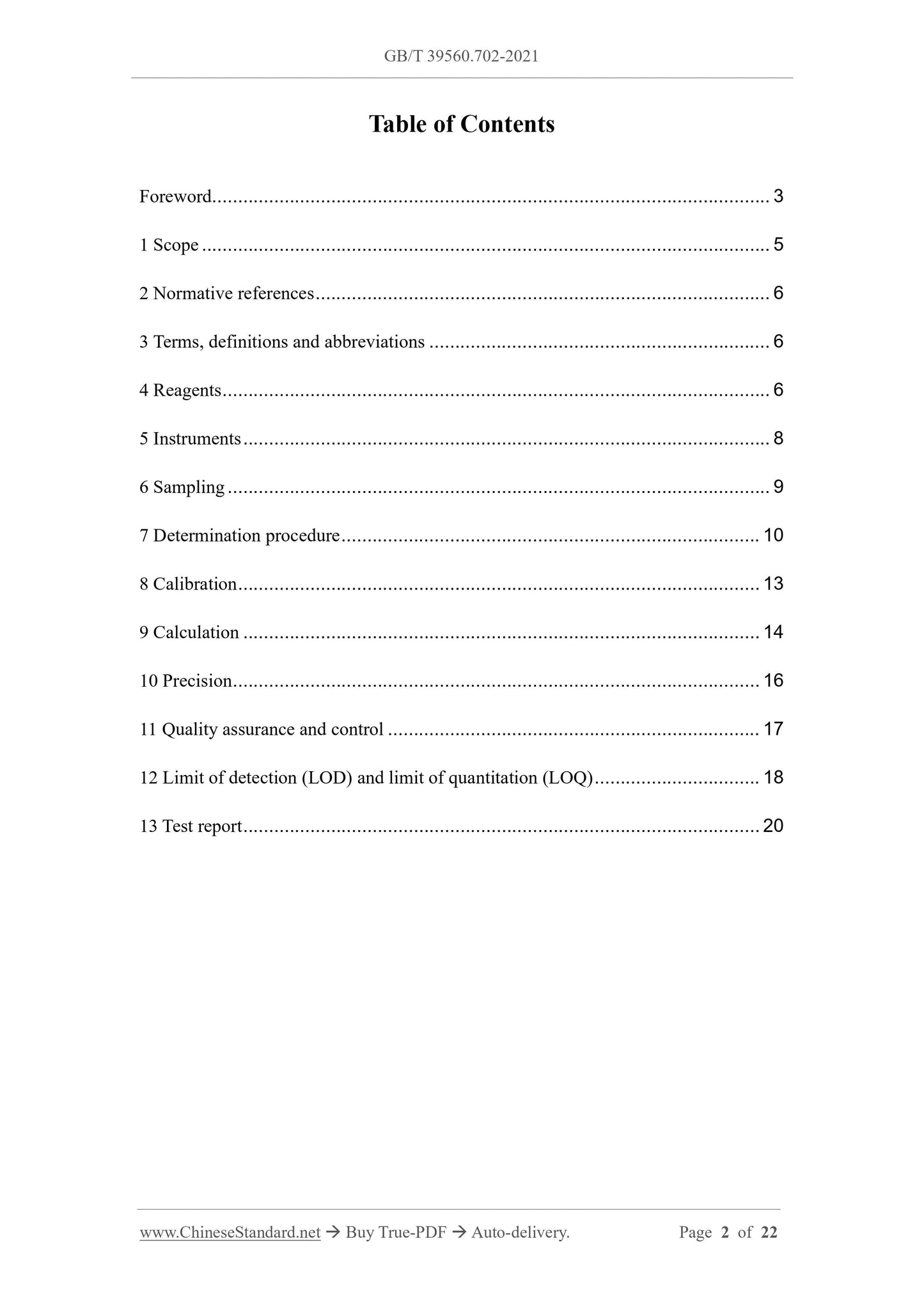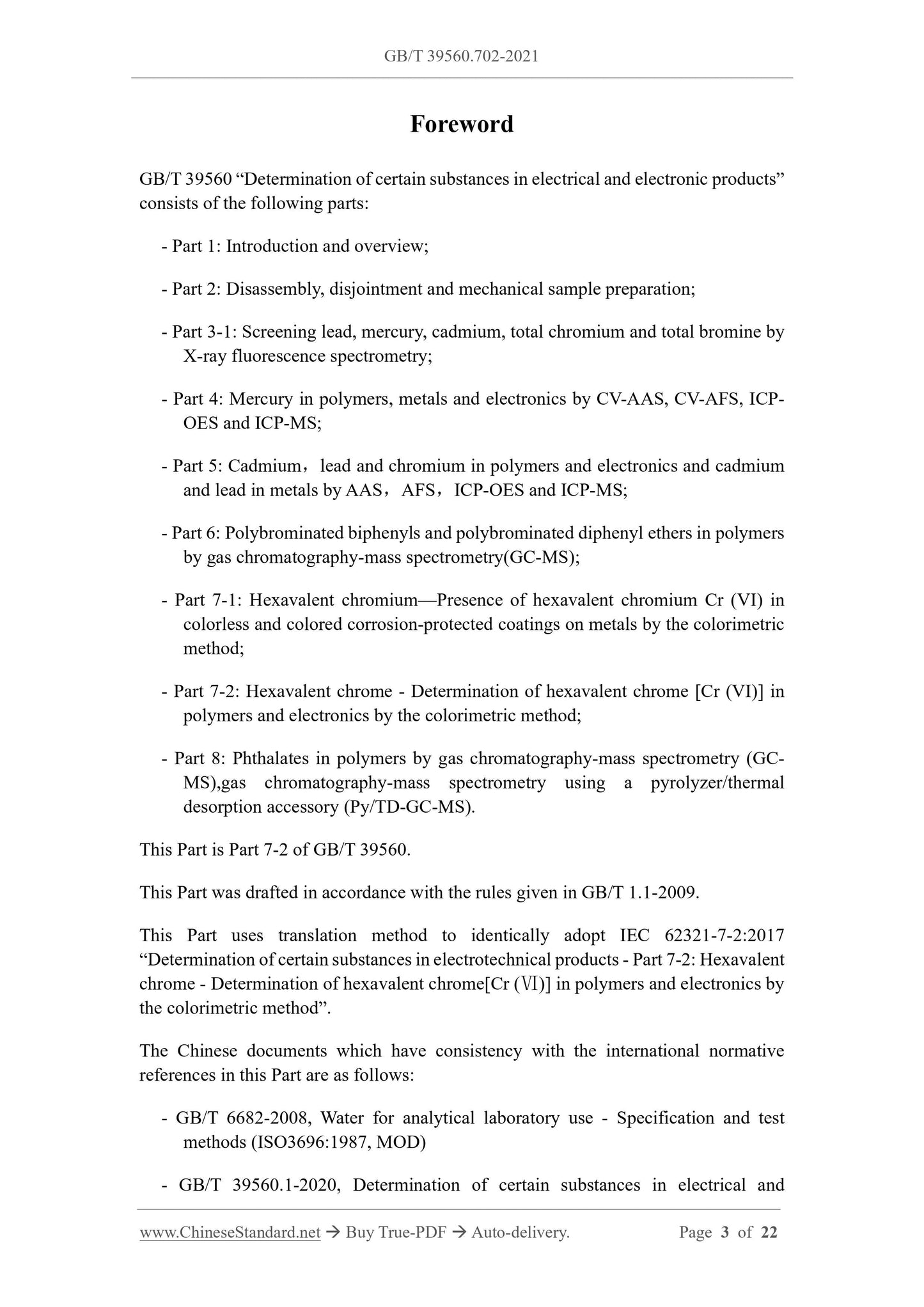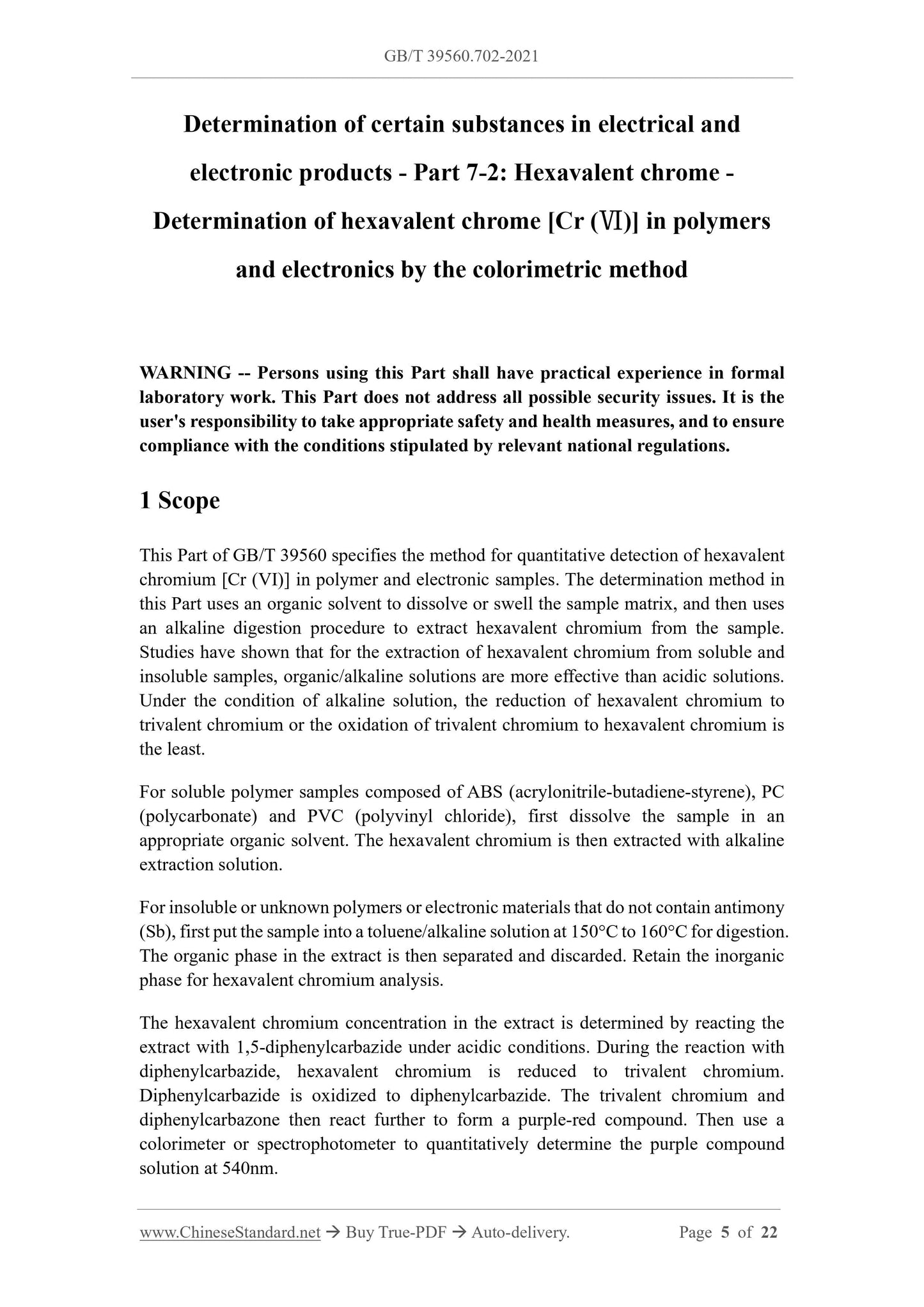1
/
of
4
PayPal, credit cards. Download editable-PDF & invoice in 1 second!
GB/T 39560.702-2021 English PDF (GBT39560.702-2021)
GB/T 39560.702-2021 English PDF (GBT39560.702-2021)
Regular price
$230.00 USD
Regular price
Sale price
$230.00 USD
Unit price
/
per
Shipping calculated at checkout.
Couldn't load pickup availability
Delivery: 3 seconds. Download true-PDF + Invoice.
Get QUOTATION in 1-minute: Click GB/T 39560.702-2021
Historical versions: GB/T 39560.702-2021
Preview True-PDF (Reload/Scroll if blank)
GB/T 39560.702-2021: Determination of certain substances in electrical and electroinic products -- Part 7-2: Hexavalent chrome -- Determination of hexavalent chrome[Cr(Ⅵ)]in polymers and electronics by the colormetric method
GB/T 39560.702-2021
NATIONAL STANDARD OF THE
PEOPLE’S REPUBLIC OF CHINA
ICS 31.020;71.040.50
L 10
GB/T 39560.702-2021 / IEC 62321-7-2:2017
Determination of certain substances in electrical and
electronic products - Part 7-2: Hexavalent chrome -
Determination of hexavalent chrome [Cr (Ⅵ)] in polymers
and electronics by the colorimetric method
(IEC 62321-7-2:2017, Determination of certain substances in electrotechnical
products - Part 7-2: Hexavalent chrome - Determination of hexavalent
chrome[Cr (Ⅵ)] in polymers and electronics by the colorimetric method, IDT)
ISSUED ON: OCTOBER 11, 2021
IMPLEMENTED ON: MAY 01, 2022
Issued by: State Administration for Market Regulation;
Standardization Administration of the People's Republic of China.
Table of Contents
Foreword ... 3
1 Scope ... 5
2 Normative references ... 6
3 Terms, definitions and abbreviations ... 6
4 Reagents ... 6
5 Instruments ... 8
6 Sampling ... 9
7 Determination procedure ... 10
8 Calibration ... 13
9 Calculation ... 14
10 Precision ... 16
11 Quality assurance and control ... 17
12 Limit of detection (LOD) and limit of quantitation (LOQ) ... 18
13 Test report ... 20
Foreword
GB/T 39560 “Determination of certain substances in electrical and electronic products”
consists of the following parts:
- Part 1: Introduction and overview;
- Part 2: Disassembly, disjointment and mechanical sample preparation;
- Part 3-1: Screening lead, mercury, cadmium, total chromium and total bromine by
X-ray fluorescence spectrometry;
- Part 4: Mercury in polymers, metals and electronics by CV-AAS, CV-AFS, ICP-
OES and ICP-MS;
- Part 5: Cadmium, lead and chromium in polymers and electronics and cadmium
and lead in metals by AAS, AFS, ICP-OES and ICP-MS;
- Part 6: Polybrominated biphenyls and polybrominated diphenyl ethers in polymers
by gas chromatography-mass spectrometry(GC-MS);
- Part 7-1: Hexavalent chromium—Presence of hexavalent chromium Cr (VI) in
colorless and colored corrosion-protected coatings on metals by the colorimetric
method;
- Part 7-2: Hexavalent chrome - Determination of hexavalent chrome [Cr (VI)] in
polymers and electronics by the colorimetric method;
- Part 8: Phthalates in polymers by gas chromatography-mass spectrometry (GC-
MS),gas chromatography-mass spectrometry using a pyrolyzer/thermal
desorption accessory (Py/TD-GC-MS).
This Part is Part 7-2 of GB/T 39560.
This Part was drafted in accordance with the rules given in GB/T 1.1-2009.
This Part uses translation method to identically adopt IEC 62321-7-2:2017
“Determination of certain substances in electrotechnical products - Part 7-2: Hexavalent
chrome - Determination of hexavalent chrome[Cr (Ⅵ)] in polymers and electronics by
the colorimetric method”.
The Chinese documents which have consistency with the international normative
references in this Part are as follows:
- GB/T 6682-2008, Water for analytical laboratory use - Specification and test
methods (ISO3696:1987, MOD)
- GB/T 39560.1-2020, Determination of certain substances in electrical and
Determination of certain substances in electrical and
electronic products - Part 7-2: Hexavalent chrome -
Determination of hexavalent chrome [Cr (Ⅵ)] in polymers
and electronics by the colorimetric method
WARNING -- Persons using this Part shall have practical experience in formal
laboratory work. This Part does not address all possible security issues. It is the
user's responsibility to take appropriate safety and health measures, and to ensure
compliance with the conditions stipulated by relevant national regulations.
1 Scope
This Part of GB/T 39560 specifies the method for quantitative detection of hexavalent
chromium [Cr (VI)] in polymer and electronic samples. The determination method in
this Part uses an organic solvent to dissolve or swell the sample matrix, and then uses
an alkaline digestion procedure to extract hexavalent chromium from the sample.
Studies have shown that for the extraction of hexavalent chromium from soluble and
insoluble samples, organic/alkaline solutions are more effective than acidic solutions.
Under the condition of alkaline solution, the reduction of hexavalent chromium to
trivalent chromium or the oxidation of trivalent chromium to hexavalent chromium is
the least.
For soluble polymer samples composed of ABS (acrylonitrile-butadiene-styrene), PC
(polycarbonate) and PVC (polyvinyl chloride), first dissolve the sample in an
appropriate organic solvent. The hexavalent chromium is then extracted with alkaline
extraction solution.
For insoluble or unknown polymers or electronic materials that do not contain antimony
(Sb), first put the sample into a toluene/alkaline solution at 150°C to 160°C for digestion.
The organic phase in the extract is then separated and discarded. Retain the inorganic
phase for hexavalent chromium analysis.
The hexavalent chromium concentration in the extract is determined by reacting the
extract with 1,5-diphenylcarbazide under acidic conditions. During the reaction with
diphenylcarbazide, hexavalent chromium is reduced to trivalent chromium.
Diphenylcarbazide is oxidized to diphenylcarbazide. The trivalent chromium and
diphenylcarbazone then react further to form a purple-red compound. Then use a
colorimeter or spectrophotometer to quantitatively determine the purple compound
solution at 540nm.
Get QUOTATION in 1-minute: Click GB/T 39560.702-2021
Historical versions: GB/T 39560.702-2021
Preview True-PDF (Reload/Scroll if blank)
GB/T 39560.702-2021: Determination of certain substances in electrical and electroinic products -- Part 7-2: Hexavalent chrome -- Determination of hexavalent chrome[Cr(Ⅵ)]in polymers and electronics by the colormetric method
GB/T 39560.702-2021
NATIONAL STANDARD OF THE
PEOPLE’S REPUBLIC OF CHINA
ICS 31.020;71.040.50
L 10
GB/T 39560.702-2021 / IEC 62321-7-2:2017
Determination of certain substances in electrical and
electronic products - Part 7-2: Hexavalent chrome -
Determination of hexavalent chrome [Cr (Ⅵ)] in polymers
and electronics by the colorimetric method
(IEC 62321-7-2:2017, Determination of certain substances in electrotechnical
products - Part 7-2: Hexavalent chrome - Determination of hexavalent
chrome[Cr (Ⅵ)] in polymers and electronics by the colorimetric method, IDT)
ISSUED ON: OCTOBER 11, 2021
IMPLEMENTED ON: MAY 01, 2022
Issued by: State Administration for Market Regulation;
Standardization Administration of the People's Republic of China.
Table of Contents
Foreword ... 3
1 Scope ... 5
2 Normative references ... 6
3 Terms, definitions and abbreviations ... 6
4 Reagents ... 6
5 Instruments ... 8
6 Sampling ... 9
7 Determination procedure ... 10
8 Calibration ... 13
9 Calculation ... 14
10 Precision ... 16
11 Quality assurance and control ... 17
12 Limit of detection (LOD) and limit of quantitation (LOQ) ... 18
13 Test report ... 20
Foreword
GB/T 39560 “Determination of certain substances in electrical and electronic products”
consists of the following parts:
- Part 1: Introduction and overview;
- Part 2: Disassembly, disjointment and mechanical sample preparation;
- Part 3-1: Screening lead, mercury, cadmium, total chromium and total bromine by
X-ray fluorescence spectrometry;
- Part 4: Mercury in polymers, metals and electronics by CV-AAS, CV-AFS, ICP-
OES and ICP-MS;
- Part 5: Cadmium, lead and chromium in polymers and electronics and cadmium
and lead in metals by AAS, AFS, ICP-OES and ICP-MS;
- Part 6: Polybrominated biphenyls and polybrominated diphenyl ethers in polymers
by gas chromatography-mass spectrometry(GC-MS);
- Part 7-1: Hexavalent chromium—Presence of hexavalent chromium Cr (VI) in
colorless and colored corrosion-protected coatings on metals by the colorimetric
method;
- Part 7-2: Hexavalent chrome - Determination of hexavalent chrome [Cr (VI)] in
polymers and electronics by the colorimetric method;
- Part 8: Phthalates in polymers by gas chromatography-mass spectrometry (GC-
MS),gas chromatography-mass spectrometry using a pyrolyzer/thermal
desorption accessory (Py/TD-GC-MS).
This Part is Part 7-2 of GB/T 39560.
This Part was drafted in accordance with the rules given in GB/T 1.1-2009.
This Part uses translation method to identically adopt IEC 62321-7-2:2017
“Determination of certain substances in electrotechnical products - Part 7-2: Hexavalent
chrome - Determination of hexavalent chrome[Cr (Ⅵ)] in polymers and electronics by
the colorimetric method”.
The Chinese documents which have consistency with the international normative
references in this Part are as follows:
- GB/T 6682-2008, Water for analytical laboratory use - Specification and test
methods (ISO3696:1987, MOD)
- GB/T 39560.1-2020, Determination of certain substances in electrical and
Determination of certain substances in electrical and
electronic products - Part 7-2: Hexavalent chrome -
Determination of hexavalent chrome [Cr (Ⅵ)] in polymers
and electronics by the colorimetric method
WARNING -- Persons using this Part shall have practical experience in formal
laboratory work. This Part does not address all possible security issues. It is the
user's responsibility to take appropriate safety and health measures, and to ensure
compliance with the conditions stipulated by relevant national regulations.
1 Scope
This Part of GB/T 39560 specifies the method for quantitative detection of hexavalent
chromium [Cr (VI)] in polymer and electronic samples. The determination method in
this Part uses an organic solvent to dissolve or swell the sample matrix, and then uses
an alkaline digestion procedure to extract hexavalent chromium from the sample.
Studies have shown that for the extraction of hexavalent chromium from soluble and
insoluble samples, organic/alkaline solutions are more effective than acidic solutions.
Under the condition of alkaline solution, the reduction of hexavalent chromium to
trivalent chromium or the oxidation of trivalent chromium to hexavalent chromium is
the least.
For soluble polymer samples composed of ABS (acrylonitrile-butadiene-styrene), PC
(polycarbonate) and PVC (polyvinyl chloride), first dissolve the sample in an
appropriate organic solvent. The hexavalent chromium is then extracted with alkaline
extraction solution.
For insoluble or unknown polymers or electronic materials that do not contain antimony
(Sb), first put the sample into a toluene/alkaline solution at 150°C to 160°C for digestion.
The organic phase in the extract is then separated and discarded. Retain the inorganic
phase for hexavalent chromium analysis.
The hexavalent chromium concentration in the extract is determined by reacting the
extract with 1,5-diphenylcarbazide under acidic conditions. During the reaction with
diphenylcarbazide, hexavalent chromium is reduced to trivalent chromium.
Diphenylcarbazide is oxidized to diphenylcarbazide. The trivalent chromium and
diphenylcarbazone then react further to form a purple-red compound. Then use a
colorimeter or spectrophotometer to quantitatively determine the purple compound
solution at 540nm.
Share








